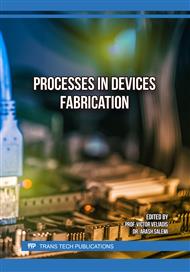[1]
A. Siddiqui, R. Y. Khosa, and M. Usman, "High-k dielectrics for 4H-silicon carbide: present status and future perspectives," J. Mater. Chem. C, vol. 9, no. 15, Art. no. 15, 2021.
DOI: 10.1039/d0tc05008c
Google Scholar
[2]
M. Nawaz, "On the Evaluation of Gate Dielectrics for 4H-SiC Based Power MOSFETs," Active and Passive Electronic Components, vol. 2015, p.1–12, Dec. 2015.
DOI: 10.1155/2015/651527
Google Scholar
[3]
J. Robertson, "Band offsets of wide-band-gap oxides and implications for future electronic devices," J. Vac. Sci. Technol. B, vol. 18, no. 3, Art. no. 3, 2000.
DOI: 10.1116/1.591472
Google Scholar
[4]
J. Robertson, "High dielectric constant oxides," Eur. Phys. J. Appl. Phys., vol. 28, no. 3, p.265–291, Dec. 2004.
DOI: 10.1051/epjap:2004206
Google Scholar
[5]
S. M. Sze and K. K. Ng, Physics of semiconductor devices, Third edition. Hoboken, NJ: Wiley-Interscience, 2007.
Google Scholar
[6]
C.-M. Hsu and J.-G. Hwu, "Investigation of carbon interstitials with varied SiO2 thickness in HfO2/SiO2/4H-SiC structure," Applied Physics Letters, vol. 101, no. 25, p.253517, Dec. 2012.
DOI: 10.1063/1.4772986
Google Scholar
[7]
J. Urresti, F. Arith, S. Olsen, N. Wright, and A. O'Neill, "Design and Analysis of High Mobility Enhancement-Mode 4H-SiC MOSFETs Using a Thin-SiO 2 /Al 2 O 3 Gate-Stack," IEEE Trans. Electron Devices, vol. 66, no. 4, p.1710–1716, Apr. 2019.
DOI: 10.1109/ted.2019.2901310
Google Scholar
[8]
M. Gutowski et al., "Thermodynamic stability of high- K dielectric metal oxides ZrO2 and HfO2 in contact with Si and SiO2," Applied Physics Letters, vol. 80, no. 11, Art. no. 11, Mar. 2002.
DOI: 10.1063/1.1458692
Google Scholar
[9]
K. Y. Cheong, J. H. Moon, D. Eom, H. J. Kim, W. Bahng, and N.-K. Kim, "Electronic Properties of Atomic-Layer-Deposited Al2O3 Thermal-Nitrided SiO2Stacking Dielectric on 4H SiC," Electrochem. Solid-State Lett., vol. 10, no. 2, p. H69, 2007.
DOI: 10.1149/1.2400728
Google Scholar
[10]
R. Mahapatra, A. K. Chakraborty, A. B. Horsfall, N. G. Wright, G. Beamson, and K. S. Coleman, "Energy-band alignment of HfO2∕SiO2∕SiC gate dielectric stack," Applied Physics Letters, vol. 92, no. 4, p.042904, Jan. 2008.
DOI: 10.1063/1.2839314
Google Scholar
[11]
K. Iwamoto et al., "Experimental evidence for the flatband voltage shift of high-k metal-oxide-semiconductor devices due to the dipole formation at the high-k∕SiO2 interface," Applied Physics Letters, vol. 92, no. 13, p.132907, Mar. 2008.
DOI: 10.1063/1.2904650
Google Scholar
[12]
S. Krause, T. Mikolajick, and U. Schroeder, "Improving HfO2 Thick Films for SiC Power Devices by Si, Y and La Doping," SSP, vol. 359, p.29–34, Aug. 2024.
DOI: 10.4028/p-yz4fux
Google Scholar
[13]
J. W. McPherson, "Increases in Lorentz Factor with Dielectric Thickness," WJCMP, vol. 06, no. 02, p.152–168, 2016.
DOI: 10.4236/wjcmp.2016.62018
Google Scholar
[14]
C. Richter et al., "Si Doped Hafnium Oxide—A 'Fragile' Ferroelectric System," Adv. Electron. Mater., vol. 3, no. 10, Art. no. 10, Oct. 2017.
Google Scholar
[15]
R. G. Southwick, J. Reed, C. Buu, R. Butler, G. Bersuker, and W. B. Knowlton, "Limitations of Poole–Frenkel Conduction in Bilayer HfO2/SiO2 MOS Devices," IEEE Trans. Device Mater. Relib., vol. 10, no. 2, Art. no. 2, Jun. 2010.
DOI: 10.1109/tdmr.2009.2039215
Google Scholar
[16]
A. Kumta, Rusli, and J. H. Xia, "Breakdown phenomena of Al-based high-k dielectric/SiO2 stack on 4H-SiC," Applied Physics Letters, vol. 94, no. 23, p.233505, Jun. 2009.
DOI: 10.1063/1.3151917
Google Scholar
[17]
A. Paskaleva, D. Spassov, and D. Dankovic, "Consideration of conduction mechanisms in high-k dielectric stacks as a tool to study electrically active defects," Facta Univ Electron Energ, vol. 30, no. 4, Art. no. 4, 2017.
DOI: 10.2298/fuee1704511p
Google Scholar
[18]
A. Vasilev et al., "Oxide and Interface Defect Analysis of lateral 4H-SiC MOSFETs through CV Characterization and TCAD Simulations," MSF, vol. 1090, p.119–126, May 2023.
DOI: 10.4028/p-k93y93
Google Scholar
[19]
R. G. Southwick and W. B. Knowlton, "Stacked Dual-Oxide MOS Energy Band Diagram Visual Representation Program (IRW Student Paper)," IEEE Trans. Device Mater. Relib., vol. 6, no. 2, p.136–145, Jun. 2006.
DOI: 10.1109/tdmr.2006.876971
Google Scholar
[20]
J. Weckbrodt, N. Ginot, C. Batard, and S. Azzopardi, "Monitoring of Gate Leakage Current on SiC Power MOSFETs: An Estimation Method for Smart Gate Drivers," IEEE Trans. Power Electron., vol. 36, no. 8, Art. no. 8, Aug. 2021.
DOI: 10.1109/tpel.2021.3056648
Google Scholar


